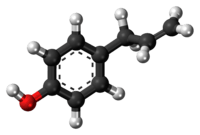Chavicol
 | |
 | |
| Names | |
|---|---|
| Preferred IUPAC name
4-(Prop-2-en-1-yl)phenol | |
| Other names
4-Allylphenol | |
| Identifiers | |
| 501-92-8 | |
| 3D model (Jmol) | Interactive image |
| ChEBI | CHEBI:50158 |
| ChEMBL | ChEMBL108862 |
| ChemSpider | 21105856 |
| ECHA InfoCard | 100.007.209 |
| UNII | Q5ER4K6969 |
| |
| |
| Properties | |
| C9H10O | |
| Molar mass | 134.18 g/mol |
| Density | 1.020 g/cm3 |
| Melting point | 16 °C (61 °F; 289 K) |
| Boiling point | 238 °C (460 °F; 511 K) (123 °C at 16 mmHg) |
| Except where otherwise noted, data are given for materials in their standard state (at 25 °C [77 °F], 100 kPa). | |
| | |
| Infobox references | |
Chavicol, or p-allylphenol, is a natural phenylpropene, a type of organic compound.[1] Its chemical structure consists of a benzene ring substituted with a hydroxy group and a propenyl group. It is a colorless liquid found together with terpenes in betel oil.
Properties
Chavicol is miscible with alcohol, ether, and chloroform.
Uses
Chavicol is used as an odorant in perfumery.
See also
References
- ↑ Lide, D. R., ed. (2005). CRC Handbook of Chemistry and Physics (86th ed.). Boca Raton (FL): CRC Press. ISBN 0-8493-0486-5.
This article is issued from Wikipedia - version of the 9/10/2016. The text is available under the Creative Commons Attribution/Share Alike but additional terms may apply for the media files.